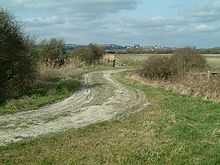Lewes Brooks
| Site of Special Scientific Interest | |
 | |
 Shown within East Sussex | |
| Area of Search | East Sussex |
|---|---|
| Grid reference | TQ410085 to TQ430075 |
| Coordinates | 50°51′14″N 0°01′05″E / 50.854°N 0.018°ECoordinates: 50°51′14″N 0°01′05″E / 50.854°N 0.018°E |
| Interest | Biological |
| Area | 333.0 ha (823 acres) |
| Notification | 1988 |
| Natural England website | |

Lewes Brooks is a 330.07 hectare (822.8 acre) biological Site of Special Scientific Interest in East Sussex, England.[1] The site was notified in 1988 under the Wildlife and Countryside Act 1981.[2] The site is situated to the south of Lewes and west of the River Ouse[3] on a flood plain, and contains many invertebrates, including beetles, snails, and flies. It is the only known UK site for the Lewes water beetle.[4] It is bounded to the south by Rodmell and Southease and to the west by Iford. A lot of mute swans and woodpigeons come here to graze and many songbirds sing in the surrounding hedges. The RSPB also reports that lapwings and snipe have bred here.
Lewes Brooks is where the Falmer-Glynde and the Ouse valleys meet.[3] The Upper and Lower Rises are the remains of the chalk uplands eroded by the Ouse.[3]
There is an RSPB reserve covering much of the area.[4]
References
"SSSI Citation — Lewes Brooks" (PDF). Natural England. Retrieved 2008-05-28.
- ↑ Natural England - SSSI units for Lewes Brooks - Natural England page listing specific areas of interest in Lewes Brooks area
- ↑ COUNTY: EAST SUSSEX SITE NAME: LEWES BROOKS DISTRICT: LEWES, English Nature report listing species of plants and insects
- ↑ 3.0 3.1 3.2 Sussex Downs Landscape Assessment, Brooks Pastures, Sussex Downs Conservation Board
- ↑ 4.0 4.1 Lewes Brooks, Royal Socieity for the Protection of Birds